




The Strategic Plan is a vision of the priorities Community Development staff will work toward in the next 5 years. It identifies and categorizes areas of focus that provide a phased approach to implementing the Aspire 2040 Comprehensive Plan and other longer range initiatives. Throughout the Strategic Plan, references from Aspire note the connections between Aspire and Community Development efforts.
The Strategic Plan is meant to inform the public of key projects and initiatives, communicate funding sources, potential redevelopment and development sites, and foster coordination between Community Development, other departments and City Council. The Strategic Plan informs workplan and CIP preparation. Understandably, the plan may change as new factors are introduced. For that reason this is meant to be a living, amendable document.
How the Community Development Strategic Plan fits into the City’s overall planning process:



Comp Plan
Updated every 10 years

Strategic Plan
Updated every 5 years


The Comprehensive Plan is the City’s guide for growth and development related to housing, transportation, land use, economic development, parks and open space, infrastructure, sustainability, equity and community health.
The Community Development Strategic Plan prioritizes Aspire 2040 initiatives and lays out a phased approach to implementing those initiatives. It also identifies potential redevelopment and development sites within the City.

Work Plan & Budget/CIP
Updated every 2 years


Annual Report
Updated yearly

Community Development’s Work Plan breaks initiatives from the Strategic Plan into shorter term goals.
The City uses a two year cycle to update their financial planning tools. The Capital Improvement Plan is reviewed on even years and coordinates the location, timing and financing of capital improvements. The City’s Budget is reviewed on odd years. It’s designed to provide taxpayers with services such as Fire and Police protection, Public Works necessities and Parks and Recreation spaces.
The Community Development Annual Report shares the department’s annual achievements.
The Community Development Department supports the long-term vitality of Eden Prairie through city-wide land use planning and development review activities, maintaining a positive environment for business, addressing housing and community service needs, and responsible property valuations.




Housing and Community Services Economic Development Planning Assessing

The Housing and Community Services Division advocates for affordable housing and administers the City’s Inclusionary Housing Policy. HCS also provides assistance, information and referrals to residents of Eden Prairie that connects them to resources meant to help them lead full, healthy lives. Another function of HCS is to support diversity, civil and human rights, and the Americans with Disabilities Act in our community – mainly through the work of the Human Rights and Diversity Commission (HRDC).
The Economic Development Division promotes business growth and retention, assists businesses with site locations, advocates for transportation and technology improvements, and represents the City on the Eden Prairie Chamber of Commerce Government Committee. A key component of economic strength is managing the needs of existing and prospective businesses to ensure a diverse mix that contributes to a stable tax base and enhances Eden Prairie’s image and regional profile.
The Planning Division works with developers, community members and organizations as a part of long-range land-use planning and current development projects. This division is responsible for maintaining the City’s comprehensive plan and zoning ordinances. Planning also provides support for the preservation of Eden Prairie history by working with the Heritage Preservation Commission (HPC).
The Assessing Division is responsible for establishing valuations and classification of all real estate properties in the City for purposes of taxation. This work is required to follow standards and procedures to comply with the Minnesota Department of Revenue and Hennepin County regulations.
The Race Equity Initiative (REI) is a critical step forward for Eden Prairie as it looks to create and strengthen community relationships, encourage shared decision-making and minimize disparities wherever possible.
The REI report, adopted by the City Council in January 2022, was drafted by the Human Rights and Diversity Commission (HRDC) in conjunction with a project consultant and City staff and is based on research and community feedback. It outlines recommendations in six main areas:
• Emergency Response
• Facilities and Programs: Accessibility and Culture
• Recruiting, Hiring and Retention
• Connection to Community
• Community Experience
• Developing Future Leaders
Project Research and Outreach
Throughout 2020 and 2021, City staff and residents were encouraged to participate in project research through individual interviews, focus groups, world cafés and online surveys. City documents and policies were also reviewed.
Next Steps

City staff will review the recommendations and begin creating plans for implementation through an interdepartmental working group. Individual departments, including Community Development, will brainstorm additional avenues for integrating race equity considerations into its work. Additional community engagement will be conducted as the plan is reviewed and implementation strategies developed.
City staff will provide an initial implementation plan and continue to provide summary reports to the City Council and HRDC on a regular basis.
Programs coordinated by the Housing & Community Services division focus on policies the City has established for housing development and preservation: inclusion of affordable housing, homeownership initiatives, maintenance and improvement of existing housing stock, and allocation of federal, state, and local funding for housing programs.
Aspire 2040: “Incentivize attainable and affordable housing options for lower-income households so they can move to and remain in Eden Prairie.”
• Timing: ongoing
• Funding: TIF, Housing Revenue Bonds, potential grant sources
• Participants: Housing & Community Services, Economic Development, Planning, Met Council, Minnesota Housing, Hennepin County
Eden Prairie has deployed several planning tools and financial mechanisms to generate affordable rental housing in recent years. The publication of Aspire 2040 kicked things off, using public engagement and other means to help shape an overall housing vision for the City through the year 2040. This was followed by a Council-selected Housing Task Force that finished its work in late 2020 with a recommendations report.

An online meeting of the Housing Task Force
Among the Housing Task Force’s chief suggestions was adoption of an Inclusionary Housing Ordinance, which the City acted on the next year. Under this ordinance, developers must provide a portion of their units at affordable rents at a preselected income threshold.
The ordinance has effectively been blended with the City’s use of Tax Increment Financing (TIF), which requires that at least 20% of units be affordable to households at or below 50% of the area median income (AMI) for as long as 26 years. When a project is subject to the ordinance and receives TIF, it must contribute an additional 5% of units affordable at or below 80% of AMI and in perpetuity. The City also recently created an affordable housing trust fund through which it can deposit a variety of funding sources and pursue several housing strategies. Staff will continue to explore other strategies to utilize this tool.
Together, these strategies have been paying dividends toward Aspire goals and toward the Met Council’s affordable housing production goal of 1,408 units before 2030, though production in the area of greatest need units affordable to households earning 30% or less of the AMI has proven difficult to produce compared to units in the 3150% range (where the City does very well) or 51-80% range. Over the past few years, the projects in the chart below have been brought online, are under construction, are through the entitlement process or otherwise look feasible.
Looking at its 10 most recent projects, Eden Prairie has reached 27.34% of its Met Council-determined affordable housing goal for the period of 2021-2030. Of this production, 72.21% is at the 50% of AMI threshold which makes sense given the frequency of the use of TIF. Coincidentally, the City is at 72% of goal at that AMI level. Looking at Met Council’s breakdown of need by AMI level shows, however, that this strong production at the 50% level, while helpful toward the overall affordability need, does not match well the need as expressed across the three “affordability bands” of the 30% and below level, the 31-50% level or the 51-80% level. For example, need at or below 30% of AMI makes up 57% of the need allocation overall, but constitutes just 7% of recent production. Similarly, units affordable between 51 and 80% of AMI make up 15% of the affordable housing need but the City has only reached 5% of goal for that category. Trying to diversify AMI levels, particularly to drive production at lower AMI levels, will be an ongoing challenge.

Aspire 2040: “Work in partnership with private and public sectors, regional, state, and federal agencies, and citizens, community groups and others to help envision and finance innovative housing demonstration projects and housing development.”
Priority/Timing: varies depending on site
Funding: TIF, Pooled TIF
Participants: Housing & Community Services, developers, intergovernmental partners
• Venture Lane parcel. Will require regulatory work as a zoning change is expected. Response to a City issued RFP and developer responses indicated vertically integrated mixed-use is challenging from a market perspective and the site may be better suited for horizontal mixed use or residential. (Additional parcel details on page 44.)
• Transit Oriented Development (TOD) housing opportunity sites. (Additional details on pages 28-30):
→ Land assembly with Montessori School (Town Center)
→ Eagle Ridge Partners property (Golden Triangle)
→ TAGS Gymnastics site (Golden Triangle)
→ City West station area
• Flying Cloud Drive and College View Drive (northeast corner). All properties listed below are guided Medium Density Residential. (Additional details on page 43.)
→ The property owned by Prince’s estate on Aztec Dr, PID 23-116-22-32-0014
→ 9051 Flying Cloud Drive
→ 9061 Flying Cloud Drive (formerly a carpet store)
→ 9125 Flying Cloud Drive
• Possible church sites may offer potential for affordable housing opportunities


Aspire 2040: “Address aging housing stock to preserve and prevent the decline of naturally occurring affordable housing.”
• Priority: near term (2023-2024)
• Funding: TBD
• Participants: Housing & Community Services, mission oriented non-profits

Potential NOAH in Eden Prairie
NOAH is typically defined as private, unsubsidized housing that is in full or in part ‘naturally’ affordable given its construction quality, age and condition. It may include housing that has ‘timed out’ of affordability restrictions, such as when low-income housing tax credits expire after 30 years or when TIF affordability ends.
Staff will create a NOAH inventory to identify properties at risk using CO-STAR data and other available sources. Establishing a clear definition for what constitutes NOAH and developing the inventory will assist with identifying sites for potential interventions in conjunction with mission-oriented non-profit buyers.
Most peer cities that have adopted NOAH definitions define it as private, unsubsidized housing where at least 60% of residents earn 60% or less of the AMI. This definition owes largely to the set parameters of mission-oriented non-profits interested in preserving this vital housing. One question for Eden Prairie is whether this definition suits the community. For example, Eden Prairie was developed later than most metro suburbs, so its stock of pre-1980 (another common threshold) developments is relatively small. Since more Eden Prairie properties are newer, they tend to have a higher class (e.g. Class A, Class B, Class C) and are generally in better condition. These factors beg the question of whether the City should match the definition commonly in use or create one that better suits its stock. By way of illustration, Eden Prairie could elect to say a NOAH property in the community is one where at least 60% of residents earn 80% of AMI or less and where the building was built pre-1990. This would enlarge the pool of properties potentially saved though it would differ from peer communities. Seeking feedback from other communities and non-profits about use of thresholds that might better fit the community should be further explored or be an early Action Plan item.
Staff will develop a NOAH action plan to ensure timely action can be taken when a threatened property nears or hits the market. The action plan should include potential partners, funding sources and protocols for intervention and is also considered a Near Term action item (2023-2024).
Aspire 2040: “Preservation of Publicly Subsidized Properties (e.g. Project-Based Section 8, LIHTC) is critical to preserving existing affordable assets and can be a cost-effective way to maintain affordability.”
Priority/Timing: ongoing
Funding: TBD
Participants: Housing & Community Services, Minnesota Housing
HCS will actively monitor properties with expiring Housing Assistance Payment (HAP) contracts or Low-Income Housing Tax Credit (LIHTC) compliance periods, which are both administered by Minnesota Housing. HAP contracts are used in “Project-Based”
Section 8, where the subsidy is tied to the property rather than to an individual household as in the Housing Choice Voucher Program. Eden Prairie has several such properties and they are a valuable resource given the consistently funded and highly affordable housing they provide. Owner participation is voluntary and can end with the expiration of a HAP contract. Staying in contact with owners regarding any intention to leave the program is a low-cost entry point to negotiate a different outcome.
LIHTC is the nation’s premier affordable housing production and preservation vehicle. Under this Department of Treasury program, developers are awarded tax credits through the State that they then sell to investors. This generates upfront money to build the project while the investor receives a tax credit they can use over a ten-year period. Though complicated and often competitive, Eden Prairie can support proposed LIHTC projects for new construction or for subsequent rehabilitation by resolution and financial contribution such as provision of bond proceeds.


Aspire 2040: “Maintain the community’s existing attainable housing stock, while providing incentives to facilitate the development of new affordable housing.”
• Priority/Timing: ongoing
• Funding: Community Development Block Grant (CDBG), Pooled Housing TIF & LAHA
• Participants: Housing & Community Services, Building Inspections


Maintaining existing housing stock and investing in quality of life improvements are cost effective methods for keeping Eden Prairie homes in good repair and a source of pride for their owners. The Housing Rehabilitation Loan Program provides up to a $15,000 loan per eligible request for essential home improvements up to a maximum of $20,000 in outstanding loans. Eligible homeowners must meet income guidelines for low or moderate income households. Loans are zero interest and have a term of 30 years. As loans are repaid, funds are recycled into making additional loans to low and moderate income homeowners. Funding details can be found in this plan’s Appendix.
Aspire 2040: “Providing rehab and retro-fit resource guides, and financial resources to make these upgrades can help retain this population in the community.”
• Priority/Timing: ongoing
• Funding: CDBG and General Fund (Senior Community Services HOME Program)
• Participants: Housing & Community Services, Senior Community Services
The City works closely with Senior Community Services, a locally-based non-profit, and provides

periodic funding through a request for proposals for the Household & Outside Maintenance for Elderly (HOME) program. The program provides low or no cost basic repairs and assistance with needed chores.
The City also offers a grant program for income-eligible seniors to make modest but necessary home improvements in an amount up to $5,000. Any funds repaid under this effort are reinvested into additional affordable housing activities. Funding details can be found in this plan’s Appendix.
Aspire 2040: “Engagement with Community Land Trusts is a means to provide an ownership opportunity to a low to moderate income household as well as to provide long-term affordability.”
• Priority/Timing: ongoing
• Funding: CDBG
• Participants: Housing & Community Services, Hennepin County
Homeownership is a cornerstone in Eden Prairie, but the cost of land and other production factors make creation of new affordable detached homes difficult. Land trust partnerships fund the acquisition of homes by a community land trust (Homes Within Reach / West Hennepin Affordable Housing Land Trust) that retains the land, rehabs the home and sells it to a lower-income family. By leasing rather than selling the land to the new homeowner, the cost is dramatically reduced as it constitutes in essence just the physical improvements to the property. Housing & Community Services strives to fund one land trust acquisition annually, depending on market availability. The City has helped fund the purchase of 18 Eden Prairie properties through Homes within Reach.



Aspire 2040: “The undersupply of housing options for lower income, owner-occupied households in Eden Prairie is a key issue for the City.“


• Priority/Timing: ongoing
• Funding: CDBG, Pooled Housing TIF & LAHA
• Participants: Housing & Community Services
The cost of a home can be daunting for first-time homebuyers. Low and moderate income households may often lack the upfront capital to purchase their first home. This program provides down payment and closing cost assistance to income qualified households. New LAHA funds will allow the City to increase the amount provided to be more aligned with neighboring communities. LAHA funds will also enable the City to initiate a new program specifically designed for First Generation First Time Homebuyers. The assistance is provided to recipients as a zero percent loan with a 30 year term and any repaid funds are reinvested into additional first-time buyer loans. Funding details can be found in this plan’s Appendix.
Aspire 2040: “Continue to provide information and resources to the community… through Housing and Community Services (HCS).”
• Priority/Timing: ongoing
• Funding: not applicable
• Participants: Housing & Community Services
The Property Mangers Collaborative is coordinated by HCS and is meant to give managers of multifamily properties in the community opportunities to network and share best practices, especially related to provision of affordable housing, working with diverse clienteles and maintaining quality landlord / tenant relations. The structure of the group was refreshed in 2022. It meets in person on a quarterly basis and a newsletter is also sent on a quarterly basis.


Aspire 2040: “Continue to provide information and resources to the community to access attainable and affordable housing through Housing and Community Services (HCS).”
Priority/Timing: near term (2023-2024)
Funding: not applicable
Participants: Housing & Community Services, Eden Prairie Community Foundation
For projects receiving City financing to provide affordability, staff will begin to integrate into development and/or TIF agreements a requirement that the developer create a satisfactory Affirmative Fair Housing Marketing Plan (AFHMP). These brief plans, a template of which is provided by HUD, are a typical requirement for projects funded by the Minnesota Housing Finance Agency and represent a best practice in soliciting tenants. With the goal of reaching those “most unlikely to apply,” an AFHMP contemplates how to market the property to diverse and often underrepresented households in the community.
Staff will develop and provide a document for tenants that outlines tenant rights, landlord responsibilities, and resources for pursuing grievances through advocacy and legal groups. Such a document could empower residents to spur positive changes in their unit or building. This was considered a critical adjunct to NOAH strategies emerging from the Housing Task Force.


Aspire 2040: “The City is open to continuing to work with HIAs and provide financing where practicable.”
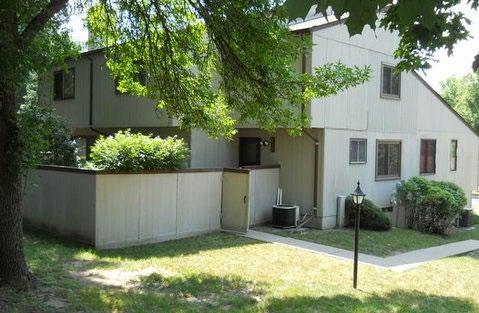

A townhouse in the St Johns Wood
homeowners association.
• Priority/Timing: ongoing – a potential option in our toolbox
• Funding: bond issuance proceeds or bank loan repaid by Special Assessments, CDBG
• Participants: Housing & Community Services
HIAs are a creation of state statute and allow cities to extend assistance to Common Interest Communities (CICs) for needed improvements. Homeowners must vote through their Homeowners Association in a strong majority to pursue and receive City assistance, which is then repaid by special assessments through the residents’ property taxes. An example is Edenvale, on Valley View Road near Mitchell Road.
Aspire 2040: “Work in partnership with private and public sectors, regional, state, and federal agencies, citizens, community groups and others to help envision and finance innovative housing demonstration projects and housing development.”

• Priority/Timing: prospective option for the future
• Funding: TBD
• Participants: Housing & Community Services
Habitat for Humanity has expanded its offerings beyond the traditional model of using donated materials and sweat equity to significantly lower the house price for a low income family. Lately Habitat has branched out into basic home repairs for low income households, veterans, and seniors; foreclosure prevention; and the Age Well at Home program that brings together housing and health care services to help seniors who wish to stay in their homes. Partnering with Habitat would bring needed resources and know-how from this well regarded organization.
Maintaining and growing Eden Prairie’s diverse economy is a key priority of the Aspire 2040 comprehensive plan. The strategies and initiatives in this section are meant to strengthen the City’s economic competitiveness by supporting programs and activities that promote business retention and expansion, stimulate economic growth, and contribute to the vitality of Eden Prairie.
Aspire 2040: “Attracting and retaining educated youth and young professionals can help bolster economic growth and development by increasing the City’s skilled workforce to create and fill innovative and high paying jobs.”

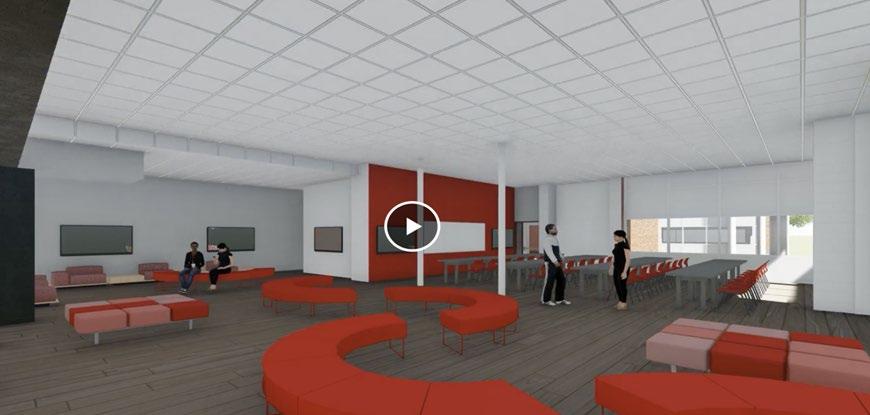
Priority/Timing: near term (2023-2024)
Funding: TBD
Participants: City, School District, Chamber of Commerce, One Million Cups
In 2020 Mayor Ron Case initiated an effort to support local entrepreneurs by:
• Improving the entrepreneurial eco-system in Eden Prairie
• Supporting projects that stimulate small business growth
• Creating alternative pathways outside the traditional college degree route
The project is a collaboration between the City, School District, Chamber of Commerce and One Million Cups to create a new entrepreneurial space at Eden Prairie High School that provides:
• Curriculums around entrepreneurship
• Mentoring and idea exchanges between entrepreneurs and students
• After-hours availability to existing entrepreneurs and One Million Cups
• The space is part of a planned renovation to EP High School with project timing expected to be announced in 2022
Aspire 2040: “Provide adequate transportation infrastructure to increase mobility. Support construction of the METRO Green Line Extension.”
Priority/Timing: ongoing
Funding: City General Fund
Participants: Eden Prairie, Minnetonka, Bloomington, Edina, Richfield, MnDOT, Hennepin County
Established in 1986, the Commission encourages economic growth and regional prosperity through improved transportation options, roads, bridges and transit as a combined solution to improve mobility. The Commission is comprised of elected officials and City staff, and is supported by representatives from MnDOT, the Metropolitan Council and the private business community. Services include:
• Working with over 1,000 employers and multi-tenant properties with resources and services aimed at converting drive-alone commuters into a sustainable commute mode.
• Promoting road, bridge, and transit projects that support economic growth and benefit area businesses and residents.
• Supporting the construction of SW Light Rail



Aspire 2040: “Establish and maintain regular lines of communication with local businesses to stay informed about expansion plans and service needs. “
Priority/Timing: ongoing
Funding: not applicable
Participants: Mayor, City Manager and Economic Development

• Staff, along with the Mayor, have discussions with business leaders though meet and greets. Over 400 meetings have been completed since 2002.
• The City continually works to increase the business community’s awareness of programs and funding (State/County/City) that are available.
• Over the last 5 years the City has had a significant level of contact with businesses impacted by the SWLRT project. Working with outreach coordinators from the SWLRT office, City staff will continue regular communication with businesses along the corridor as needed until the project is complete.
In addition to business meet and greets, staff participates in Chamber of Commerce meetings and committees, and the City conducts a business survey every 3 years –most recently in 2022.


Aspire 2040: “To make TOD areas unique destinations for the community, Eden Prairie should capitalize on TOD zoning by…Establishing a multimodal transportation hub by connecting transit with bicycle and pedestrian infrastructure (bicycle lanes, bike sharing, and racks) along with sidewalks, trails, and paths.”
Priority/Timing: ongoing
Funding: Economic Development Fund, Pooled TIF, grants
Participation: Economic Development, Planning, Engineering, Parks, SW Transit
Creating attractive and inviting streetscapes in the City’s Town Center and station areas is an important goal for the City and can help stimulate economic development activity and private investment in these areas. Providing better access to stations for pedestrians, bikers, and micro-mobility users (commuters) is also a goal and high priority that supports business by making the last mile connection achievable. All the following projects meet these goals:
• Town Center Pedestrian Connections (County TOD grant) (Near Term)
• West 70th Street completion –East segment (Near Term)
• Golden Triangle Area Trail Connections (Near Term)
• City West Area Trail Connections (Mid Term)
• “Last Mile” Study (circulators or other connections to LRT) (Mid Term)
• North South Roadway in Town Center (Long Term)

Aspire 2040: “Partner with local and state agencies to provide financing for business growth and expansion.”

Priority/Timing: ongoing
Funding: City General Fund and Hennepin County
Participants: City of Eden Prairie, local businesses, Metropolitan Consortium of Community Developers (MCCD), Hennepin County
This is a technical assistance program for small businesses funded through a partnership between Eden Prairie and Hennepin County. Services include business plan development, marketing and feasibility studies, cash flow and financing projections, loan request preparation, and advocacy with lending institutions.
Aspire 2040: “That we, as representatives of Eden Prairie businesses, city government, educational and religious institutions, accept special roles and responsibilities in fostering diversity in our community.”
Priority/Timing: ongoing
Funding: Hennepin County
Participants: small businesses in Hennepin County
Entrepreneurs and start-up business owners in Hennepin County can access free consulting services through business advisors that offer expert support in a wide range of areas including:
• Legal guidance
• Financial planning
• Marketing
• Access to capital
• Research and write business plans
• Training and education
• Access to community-based lenders
Created in response to business impacts caused by the Covid 19 pandemic, Elevate Business has now grown into an innovative model to help diverse businesses grow and build for success long into the future. Elevate Business is available to all businesses but focuses on economic empowerment of people of color, women, and other underserved business owners that have historically experienced disparities and were disproportionately impacted by the pandemic.


Aspire 2040: “Establish and maintain regular lines of communication with local businesses to stay informed about expansion plans and service needs.”
Priority/Timing: ongoing
Funding: not applicable
Participants: partnership between City, Schools and MPLS Area Realtors
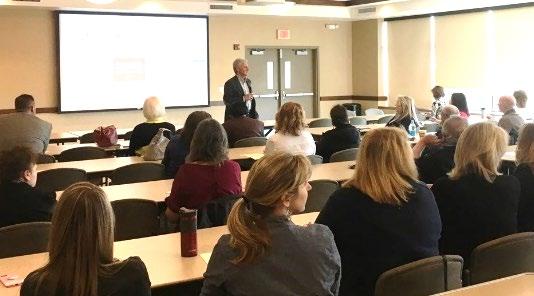

About every two years since 2011 the City has organized and hosted an educational forum with bus tours for area realtors to learn about emerging community development projects and school initiatives. The event has been popular and usually attracts about 100 participants. Attendees qualify for continuing education credits.
Aspire 2040: “Partner with the Chamber of Commerce, local and state agencies, and education institutions on workforce development initiatives.”
Priority/Timing: ongoing
Funding: not applicable
Participants: Chamber of Commerce, City, School District
Through participation on the Chamber’s Workforce Committee, City staff in 2014 helped create an annual Career Expo held at Eden Prairie High School where 800 students have an opportunity to meet with over 50 local companies to learn more about career opportunities in their industries.


Aspire 2040: “Encourage unique, attractive destinations. Create unique City entry monument signs at key locations.”
Priority/Timing: near term
Funding: Economic Development Fund
Participants: Economic Development, Parks, Engineering
In 2013 the Flying Red Horse was donated to the City by the former owners of a Mobil station located at Flying Cloud Drive and West 78th Street. The historic piece, originally erected in 1936, will be installed over a monument in a public plaza located at the corner of Flying Cloud Drive and Town Center Place – near its original location. The monument will identify entry into the City’s Town Center. The project is expected to be implemented in 2023.
SIGN APPROACH
ACl'>l"laelll wal< ,ecais 1hehllk'lry d1he Mobil Pega-ho"Mllgnw'imloca_,,.lorln111tpNliv9aig~ l:lprovid,ailsightlntolhehll!OlyoflhflFlylngRlldHotun EdenPra.i.. nw,-•abohasanopenar•asurtablislor selflllslWlllheflylngRlldHorHasabackdfop.maklng~ aplaoemaklngic:on.TheindMd.JalMobllaignpanllisdetachedlromlheiroldinffltrucWr•andHCUrlldlOlhe newooncrt1lllbaH TI'MIPegasu1imaglllllil'MtlllED& The Googl&-SlyladnlgnmaqUNsignallowl lorviewlngtom bolhllclllloll'lllrnanurMflt-...tllhllwardsEdenPfalrillkwtth LEO s Thll~s,;inllintegratlldlnloabeseatrucllft 1h11lift:llhlllign1¥110fbettefYlewingandisrel'lecliYeoflhll newstreislscallpispl;interwahand stone ..,_...c:oneistent with 1h11 main Edisn Prllirlel emanoa morunent llgn1 I NTERPRETIVE SIGNAG E EXAMP LES



Aspire 2040: “Promote a sense of community.”
Priority/Timing: near term
Funding: Community Development/Planning budget
Participants: Community Development, Parks, Facilities, Administration
The Dorenkemper House was built around the late 1850’s and was originally located south of Pioneer Trail, near Riley Creek in Southwest Eden Prairie. It was moved to Riley Lake Park in 2002 when its original site was developed into a residential subdivision called Settlers Ridge. The house was restored in 2006 and designated as a Heritage Preservation site in 2015. It has been fully furnished with items donated by the Historical Society.
Since its restoration, the home has experienced minimal use and access by the public. In July 2022 Maxfield Research was retained to conduct a market study to evaluate the potential for using the home and site for commercial or civic uses that generate greater public access and enjoyment of the property. The study is expected to be completed in late October and the findings will be discussed with the Heritage Preservation Commission and City Council late in 2022 or early 2023.

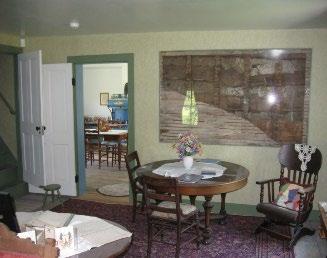

The City has established a long term vision for the development of land uses within Eden Prairie. This vision is reflected through the adoption of several policy documents including Aspire Eden Prairie 2040, Eden Prairie Design Guidelines, the Major Center Area Study, and the Town Center Design Guidelines. Collectively these policies lay the foundation for future development and redevelopment within Eden Prairie. This section will highlight redevelopment opportunity sites consistent with these policy documents; identify the Community Development divisions that will be directly involved in redevelopment efforts; and identify potential timeline(s) and whether any City resources may be anticipated to support redevelopment efforts.






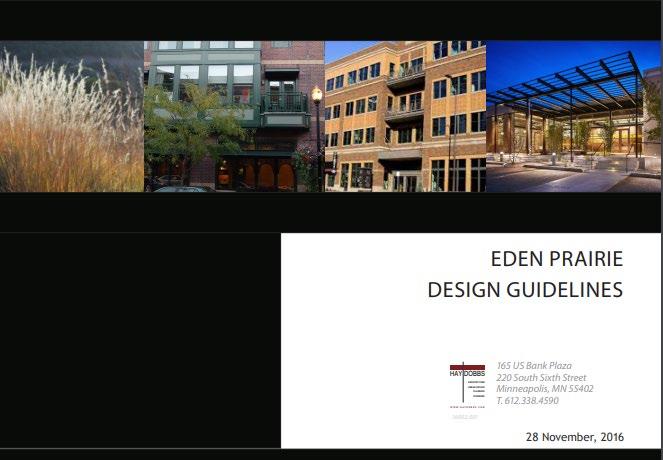

Aspire 2040: “As development and redevelopment occurs near transit facilities, the City envisions creating urban environments that have a distinct character but at the same time relate to the rest of the community.”
Priority/Timing: ongoing
Funding: TIF, Pooled TIF, TOD Grants (Met Council & Hennepin County)
Participants: Planning, Housing & Community Services, Economic Development
Construction on the Green Line LRT Extension (also known as the Southwest LRT Green Line) is well underway, with the line expected to begin operating in 2027. Areas around the City’s four transit stations will continue to be the focus for Transit Oriented Development (TOD).


TOD is a land use pattern intended to support transit system investments by creating attractive, compact, pedestrian oriented, high density, mixed use and environmentally and economically sustainable communities centered around transit facilities. There are various sites near station areas with great potential for redevelopment that could accommodate opportunities for multi-family residential, office, commercial, and light industrial uses.
Housing in TOD and the Major Center Area (MCA) will support the investment in LRT and provide increased ridership, as well as provide improved access to employment, transit, and resources. Development that includes high density residential provides a variety and diversity of housing options that reflect current and future community needs in proximity to the LRT corridor.
Aspire guides several properties at each of the station areas for TOD development. As reinvestment along the LRT corridor continues, it is expected that additional properties will seek to be considered for guiding and zoning for TOD development. The principles that guide development of TOD properties are outlined in Aspire and include: high density, rich mix of land uses, pedestrian oriented, urban pattern, parking solutions, engaging public spaces, safety, high quality architecture, and sustainable development.

At City West station, Optum’s approved phase three, ten-story office building that will be located directly adjacent to the City West station could be constructed in the next five years. If Optum elects not to develop, the site would be well suited for other uses including hotel or residential. Other potential TOD sites near this station include: Shady Oak Center at 6399 City West Parkway and American Investors Office at 6385 Old Shady Oak Road.

With changing trends in the industrial market and buildings within this area aging, several properties near the Golden Triangle station are positioned for redevelopment. Pending construction of the Greco/Eagle Ridge Partners project is expected to stimulate additional TOD development in the area. Other potential TOD sites include the TAGS building at 10300 W 70th Street and 6871 and 6851 Flying Cloud Drive.


Town Center station is located in the area that’s been planned as Eden Prairie’s Town Center. The Town Center is generally located between Prairie Center Drive, Flying Cloud Drive, Technology Drive and Regional Center Drive. The Town Center zoning and design guidelines establish similar development patterns and expectations to the principles associated with TOD development while maintaining characteristics unique to the Major Center Area (MCA). When Aspire was approved, the majority of properties within the Town Center remained guided for Town Center development with the exception of 12001 and 12011 Technology Drive. These properties are guided for TOD development due to the TOD sub-districts’ ability to accommodate employment opportunities consistent with light industrial uses. The Town Center sub-districts promote a pedestrian scale and compact area with a dynamic mix of land uses. Additional details regarding the Town Center area and planned development can be found on page 37.
As the only multi-modal transit stop in Eden Prairie, this station area is already home to TOD development. Elevate at SouthWest Station includes 222 residential units above approximately 13,000 square feet of retail space and additional area for structured parking. Other potential TOD sites may emerge as reinvestment in surrounding properties occurs.

Aspire 2040: “The vision for the Town Center area is to create an urban village with a ‘Main Street’ feel.”

Priority/Timing: ongoing
Funding: TBD
Participants: Planning, Housing & Community Services, Economic Development
The Major Center Area (MCA) study established the creation of a Town Center. The Town Center is generally located along Singletree Lane between Prairie Center Drive and Flying Cloud Drive. This area is intended to be a pedestrian scale, compact area with a vibrant mix of land uses that encourages people to live, shop, work, and play. The MCA proposes the creation of a Town Center with a retail and housing core and a walkable main street.
The land uses identified for the Town Center include mixed use (retail and office on the first floor and residential above), retail, entertainment, restaurants, services, office, residential and hospitality.
Several properties are positioned for redevelopment in the Town Center, including: the properties along Glen Lane, Bowlero, Walmart, CarX, and Jiffy Lube. The Cityowned property currently leased to EP Montessori on Singletree Lane is intended to eventually be assembled with other properties for redevelopment.
The long term plan for the area includes the construction of a north/south Main Street connection between Singletree Lane and Technology Drive. Phase I of this roadway would connect Singletree Lane to Town Center Place. This overall improvement would include specific streetscape and design standards to promote pedestrian connections and an active street environment. Economic Development funds may be a potential funding source to achieve this effect.
Priority/Timing: ongoing
Funding: TBD
Participants: Planning, Economic Dev, Housing & Community Services
Aspire 2040 created a new land use designation of Mixed Use. Properties guided for Mixed Use development were predominantly located at and around Eden Prairie Center. The City’s Aspire plan states “For retail malls to maintain long term staying power, a wider mix of additional uses should be considered that are synergistic to retail, help attract more customers and shoppers, and are connected physically to the mall or are in immediate proximity.” As opportunities to redevelop portions of the mall and nearby properties emerge, staff will continue to promote alternative mixed uses to help ensure the long term success of Eden Prairie Center area.
Additional areas guided for Mixed Use development include: the east and west ends of Martin Drive, Flying Cloud Commons, the Fountain Place area and Tower Square (the area immediately adjacent to the mall along Flying Cloud Drive and Prairie Center Drive). The Flying Cloud Commons area was recently developed as a horizontal mixed use development, consistent with Aspire.


Next steps to implement the Mixed Use land use category include creating zoning district regulations that identify permitted uses and performance standards that would apply to properties guided for mixed use. This code amendment is expected in 2023.
Aspire 2040: “Hotels, housing, professional offices and entertainment destinations would increase both the daytime and nighttime populations, benefitting nearby retail businesses and helping to further diversify Eden Prairie’s economy. The City should coordinate with mall representatives and business owners to add these uses to Eden Prairie Center when large vacancies occur.”
Priority/Timing: near term (2022-2023)
Funding: private (no City contribution)
Participants: Property owners, Planning, Economic Dev, Housing & Community Services
Eden Prairie Center is an important economic asset to the community and region with over 1.3 million square feet of retail and entertainment related uses. To help ensure the mall’s long-term vitality, staff is encouraging ownership to consider alternative uses that have a synergistic relationship to retail for any future redevelopment opportunities.
In early 2022, Hines Company was retained by mall ownership to conduct a market study and master plan for the 11-acre area currently occupied by JC Penney. City staff is collaborating with Hines in this effort and will include evaluating housing, hotel, office and entertainment uses to potentially replace future vacancies. Repositioning and expanding the uses allowed in and around the mall property is consistent with the policies and implementation strategies outlined in Aspire to maintain the long term viability and success of Eden Prairie Center.




Aspire 2040: Focus on created a more dynamic mix of land uses throughout Eden Prairie.
Priority/Timing: ongoing
Funding: TIF, Pooled TIF, TOD grants (Met Council and Hennepin County)
Participants: Planning, Housing & Community Services, Economic Development
Opportunities for large scale redevelopment exist in several areas in Eden Prairie. Although the timing of these future developments is uncertain, they have potential for generating significant value and helping meet the goals of Aspire 2040.
In 2017 the Minnesota Vikings vacated Winter Park, the 12-acre Eden Prairie training center, for a new facility in Eagan. Since 2018 the Vikings have leased the property to Lifetime Fitness, which operates a private soccer fitness center.
Viking’s ownership met with staff on several occasions over the past four years to discuss various redevelopment concepts including apartments, office, hotel, and commercial uses. The most recent concept shared in late 2021 was for high density apartments and a mid-rise office building. A small amount of commercial use primarily to serve the apartment residents was also discussed. Staff will continue to collaborate with the Vikings on optimizing the redevelopment potential of the site but with a focus on high density residential development with an element of affordable housing.

United Natural Food Inc is the largest publicly traded wholesale distributor of food in the U.S. They own a 100+ acre corporate campus located on the south end of Bryant Lake that has capacity for additional office and high density residential development. Although most of the campus is zoned office, the westerly area is guided in Aspire 2040 for medium high density residential development.
In 2021 UNFI indicated they are evaluating various development options and may seek a developer partner to help master plan and develop part of the property.

United Natural Foods Incorporated (UNFI) 105 acres 11840 Valley View Road
Optum, a subsidiary of UnitedHealth Group, is a pharmacy benefit manager and health care provider. Their 70-acre corporate headquarters is located in Eden Prairie at the corner of Shady Oak Road and Crosstown 62. They also currently lease a 400,000 square foot office building on Technology Drive near Eden Prairie City Center.
Bryant Lake
Contiguous to this leased building is a 35-acre parcel owned by Optum/United Health Group that’s being held for potential future corporate expansion. The property is zoned industrial and guided office, but could be considered for office, residential or mixed use.
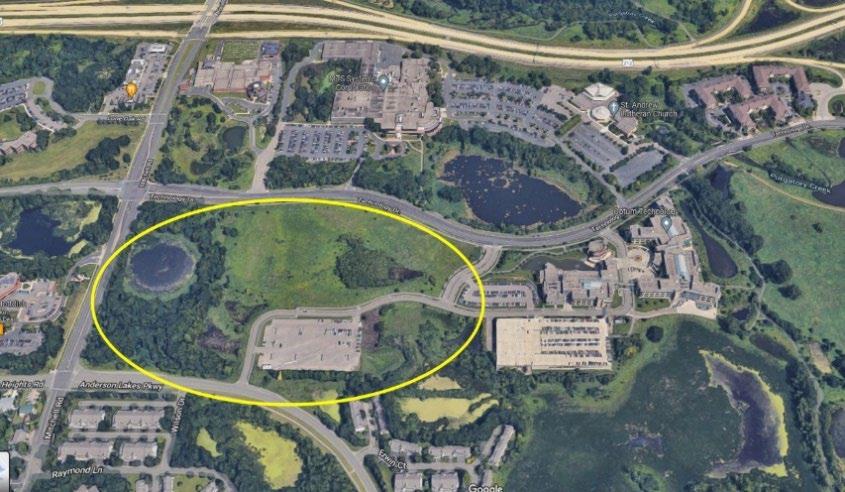
Optum/United Health Care 35 Acres 13625 Technology Drive
Tennant is a publicly traded company that provides products used to clean and coat floor surfaces. In 2019 they purchased a 40-acre campus in Eden Prairie located on Anderson Lakes as their new global headquarters. The campus was formerly owned by Element, GE Fleet Services, and Gelco Corporation. In 2020 they demolished the easterly office building and may eventually replace it with a new research and development (R&D) facility.
The campus also has 15-acres of vacant developable property guided in Aspire 2040 for industrial flex tech and office. The company has indicated they may use the property for future corporate expansion or possibly sell some of it. Although the property is guided for office it could potentially support mixed-use development as well.

Aspire 2040: “Special Study Area Plans are intended to provide clear direction for future development and reinvestment.”
Priority/Timing: mid term (2025-2026)
Funding: Community Development/Planning budget
Participation: Planning, Economic Development, Housing & Community Services

Located east of Eden Prairie Road, south of Hwy 5, and north of 212, this area includes a wide range of land uses that may not be compatible in the long term. Some properties are nearing the end of their useful life and will need updates, which will provide opportunities for redevelopment. A special area study would help analyze how to maximize efficient site design while promoting land uses reflecting current trends and long term needs of the community. It would also proactively position the City to respond to development and redevelopment opportunities as they emerge. In the near term, City staff will determine how to best develop a special study area for this neighborhood. The study would aim to collect and analyze data regarding existing uses, ages and uses of structures, traffic patterns, market forces and community needs.
The properties located adjacent to Eden Prairie Center to the south and west along Flying Cloud Drive and Prairie Center Drive have been developed as retail uses. These properties have been guided for mixed use development in Aspire 2040.


While immediately adjacent to the mall, this area has different traffic circulation and site design parameters that should be considered as a part of any redevelopment in and around the mall area. Reviewing this area with an eye toward redevelopment potential would inform improvements to the broader area and look to create synergy between these properties and the mall.
Priority/Timing: ongoing
Funding: not applicable
Participation: Planning, Economic Development
Martin Drive
The Aspire 2040 plan includes a special area study of the Martin Drive area between Venture Lane and Mitchell Road. This is an area of the City that is comprised of aging industrial buildings that have begun to be repurposed for other uses. The objective of the study was to determine the best long term land uses for the area and the City. Implementation of the study includes the creation of the Flex Service zoning district to reflect the long term plans for this area. The creation of Flex Service is intended to be a short term effort with improvements and reinvestment more likely to occur in the long term.
The Aspire 2040 plan considers two potential routes for this area: remain an older industrial hub or transform into a new business park. The area has potential for redevelopment if enough parcels can be assembled, but because of past industrial uses will require soil testing and possible environmental remediation. Potential uses could include industrial, office and limited commercial. Remaining an older industrial hub would include drafting amendments to City Code to address performance standards and permitted land uses to reflect the unique characteristics of this area. These amendments are expected as short to mid term priorities while reinvestment/redevelopment is expected as a long term item.


Aspire 2040: “Properties with this (Eco Innovation) designation shall be sized adequately to have the capacity to provide for appropriate transition areas or buffers from existing or planned differing land uses.”

Priority/Timing: depends on supporting legislation
Funding: TBD
Participants: Public Works, Planning, MPCA
Regulatory: new zoning district
Aspire 2040 guides the former Flying Cloud Landfill site for Eco Innovation land uses. The intention is to provide opportunities for land uses on the property that promote sustainability, specifically solar uses, in order to maximize the use of the area. This effort will include creating a zoning district that corresponds to the Eco Innovation land use guiding and could be applied to other properties within the community as appropriate. Staff is in the process of drafting the zoning district language. City staff will coordinate efforts with Public Works staff, Commissions and SolSmart with the Metropolitan Council. Development of additional use(s) on the former landfill site will require collaboration with the Minnesota Pollution Control Agency (MPCA) as owner of the property and adoption of the MPCA’s final land use plan.
Aspire 2040: “Facilitate development of a full-service hotel with meeting space and entertainment uses on key redevelopment/infill sites.”
Priority/Timing: ongoing
Funding: TBD
Participants: Planning, Economic Development
Eden Prairie lacks a full-service/hybrid hotel with meeting space. Attracting this type of facility remains a priority for the City. In 2014, national hotel consultant HVS was retained to evaluate Eden Prairie Center Concept

the hotel market in Eden Prairie. The study found this market could support a hybrid hotel and identified potential sites including Eden Prairie Center, Winter Park, and the LRT station areas at City West and Golden Triangle. As of 2022 City staff is in discussions with representatives of Eden Prairie Center about the possibility of a hotel as part of a larger redevelopment.
The City regularly reviews properties that have been identified as having development potential or that staff receives inquiries about. Although the City doesn’t control how or when the sites develop, its helpful information to have on hand when developers ask for advice about locations for prospective projects. This section shares many of the properties City staff has identified as having development opportunities or has received inquiries on from the development community.

Mill Creek property (1.6 acres)
Zoned RM-6.5
Guided Medium Density Residential Current pending application

10821 Blossom Road (0.9 acres) Zoned R1-22
Guided Low Density Residential Current pending application
Section 4: Potential Infill Sites

Life Church properties (8 acres)
13901 St. Andrew Drive and 14100 Valley View Road
Zoned and Guided Public

Marshall Farm (30.5 acres)
9905 Dell Road
Zoned Rural
Guided Low Density Residential
Section 4: Potential Infill Sites


Vacant property (0.9 acres)
9051 Flying Cloud Drive (2.22 acres)
9061 Flying Cloud Drive (2.3 acres)
9125 Flying Cloud Drive (2 acres)
All Zoned I-2
All Guided for Medium Density Residential
*This location is also mentioned on page 9, Affordable Housing Opportunity Sites
Marshall Farm Stand (3.5 acres)
North of Pioneer Trail
Zoned Rural
Guided Low Density Residential
Eden Heights East (1.3 acres)
South of Pioneer Trail
Zoned R1-22
Guided Low Density Residential
* This property has an approved preliminary plat to create 4 lots
Section 4: Potential Infill Sites

Drive (5.72 acres)
Section 4: Potential Infill Sites
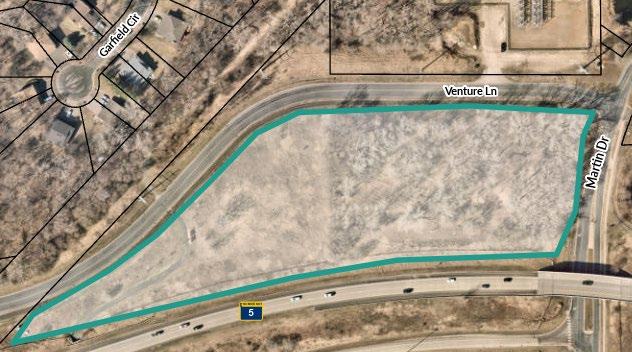
MnDOT/Venture Lane property (approximately 5.8 acres)
Not platted/zoned
Guided Mixed Use
*This location is also mentioned on page 9, Affordable Housing Opportunity Sites
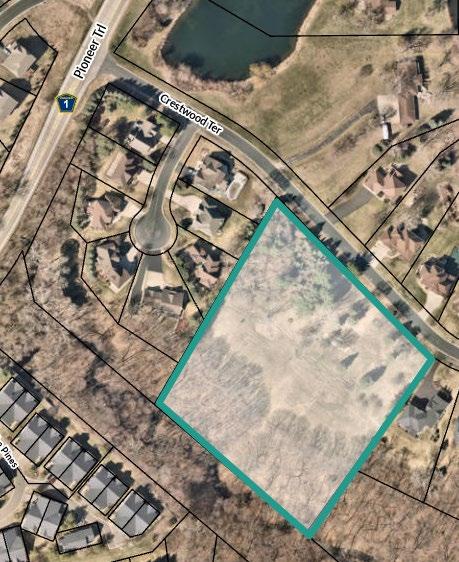
9614 Crestwood Terrace (4.7 acres)
Zoned Rural Guided Low Density Residential
Section 4: Potential Infill Sites


Huber Funeral Home
16394 Glory Lane
Zoned I-2
Guided Commercial
Kline property (4.8 acres) 9700 Eden Prairie Road
Pemtom property (1.7 acres) 9740 Eden Prairie Road
Bunn property (0.9 acres) 9850 Eden Prairie Road
All Zoned Rural
All Guided Low Density Residential
Section 4: Potential Infill Sites
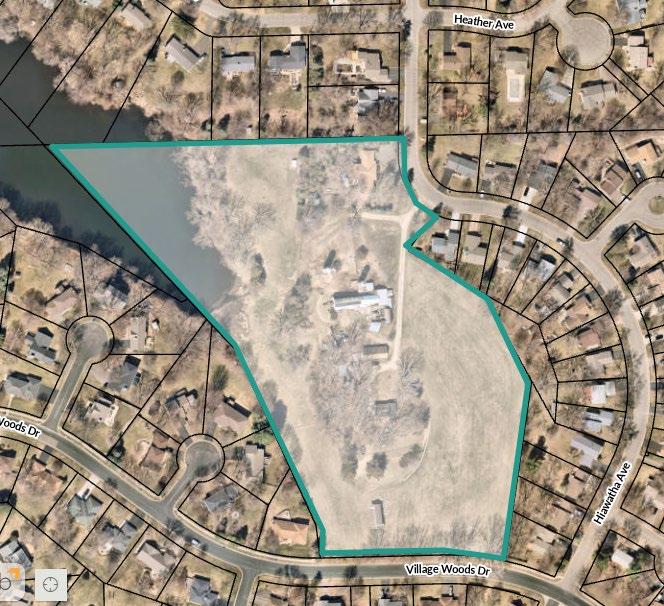

Seifert property (11.2 acres)
8390 Hiawatha Ave
Zoned Rural
Guided Low Density Residential
Kurt Johnson property (2.2 acres)
11111 Anderson Lakes Pkwy
Zoned R1-22
Guided Medium High Density
Residential
Section 4: Potential Infill Sites
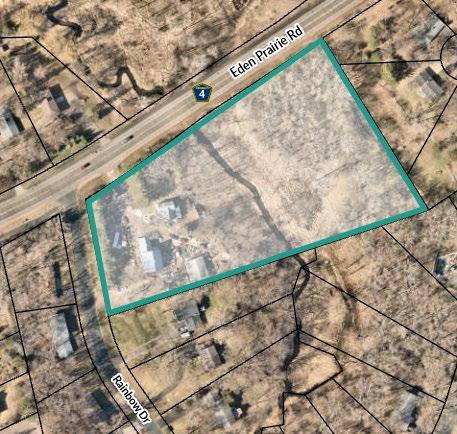
Martin property (4.9 acres)
6585 Eden Prairie Road
Zoned R1-22
Guided Low Density Residential

6385 Old Shady Oak Road (6.1 acres)
Zoned Office
Guided Industrial Flex Tech
*This location is also mentioned on page 28, TOD Opportunity Sites
Section 4: Potential Infill Sites


6216 Baker Road (3.8 acres)
Zoned and Guided Office
9000 and 9002 Riley Lake Road (9.42 acres)
Zoned Rural
Guided Low Density Residential
Section 4: Potential Infill Sites

John Lassen properties (9 acres)
7025 Baker Road
Zoned Rural
Guided Medium Density Residential
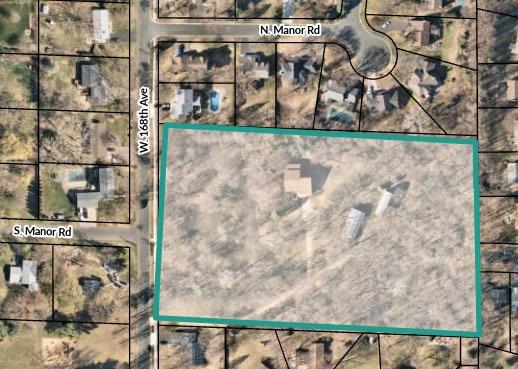
Gerald Moot property (6.4 acres)
6591 168th Street W
Zoned Rural
Guided Low Density Residential
Section 4: Potential Infill Sites

Vacant property (1 acre)
Hennepin Town Road
Zoned Office
Guided Commercial

Ingram property (5.9 acres)
18900 Pioneer Trail
Zoned Rural
Guided Low Density Residential

18011 Pioneer Trail (1 acre)
Zoned Rural
Guided Low Density Residential
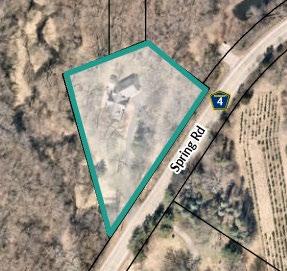
9900 Spring Road (1.5 acres)
Zoned Rural
Guided Low Density Residential

9500 Flying Cloud Drive (3.44 acres)
Zoned Rural Guided Low Density Residential
Section 4: Potential Infill Sites

17325 and 17305 Pioneer Trail (5.7 acres total)
Both Zoned Rural
Both Guided Medium Density
Residential

16870 Beverly Drive (5.1 acres)
17020 Beverly Drive (4.2 acres)
17170 Beverly Drive (5.4 acres)
17135 Beverly Drive (5 acres)
All Zoned Rural, all Guided Low Density Residential
Section 4: Potential Infill Sites


Dvorak Farm (5.8 acres)
6745 and 6685 Flying Cloud Drive
Zoned I-5
Guided Industrial Flex Tech
Former Pauley property (4.3 acres)
17450 78th St W
Zoned R1-22
Guided Low Density Residential

10001 Dell Road (6.1 acre)
10003 Dell Road (7 acres)
10005 Dell road (5.5 acres)
10011 Dell Road (12.9 acres)
All Zoned Rural
All Guided Low Density Residential above MUSA line and Rural MUSA line

18392 and 19108 Twilight Trail (both just over 1 acre)
Zoned R1-13.5
Guided Low Density Residential

Hennepin County property (0.69 acres)
8928 Preserve Blvd
Zoned RM-6.5
Guided Medium Density Residential
Section 4: Potential Infill Sites

10720 Hennepin Town Road (4 acres)
Zoned Rural
Guided Low Density Residential
Saunders properties (58 acres)
Zoned Rural
Guided Low Density Residential and Parks/Open Space
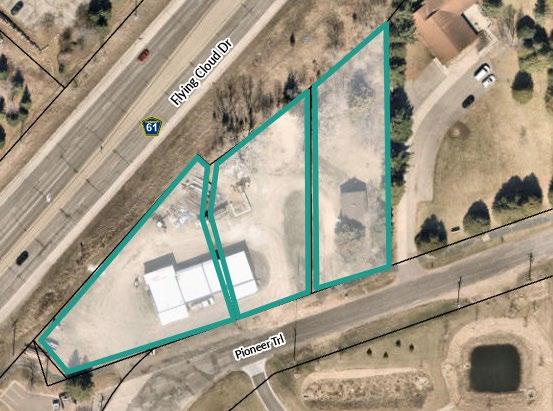
13160, 13120 and 13090 Pioneer Trail (1.39 acres)
Two are zoned Industrial, one is zoned Rural
All guided Commercial
The incremental taxes generated from the increased value (assessed value) of an improved property/new housing project are used to help finance qualified improvements over a specific period. Projects financed with TIF housing funds must provide rents affordable to persons with income below 50% of the Area Median Income (AMI) on 20% of the total units, or below 60% of AMI on a minimum of 40% of the total units. Required affordability in TIF districts typically lasts 26 years.
Existing TIF Housing Districts often include provisions for a percentage of the tax increment funds to be pooled for future affordable housing projects. These funds can be used to help finance new affordable housing development or improvements to existing units as a long as income limits are met by the residents. These funds can also help support City programs such as the First Time Homebuyer Program and Housing Rehab Program for residents with moderate incomes who do not qualify for CDBG (see below). A small percentage of the tax increment from projects is also allocated to cover administrative expenses. These TIF Admin funds can be used for staff time and attorney and consultant costs.
Created by HUD in 1974, this federal program provides annual entitlements to qualifying cities based on a population, age of housing and poverty level formula. Cities have the flexibility to use these funds in a variety of ways to address issues affecting residents with low to moderate incomes. Eden Prairie dedicates 85% of its funding for housing related activities: the First-Time Home Buyer Program, Community Land Trusts, and the Housing Rehabilitation Loan Program. CDBGfinanced projects must provide rents or otherwise serve households with an income below 80% of AMI. 15% of CDBG funds are used for social services grants to organizations such as PROP, Senior Community Services, and Meals on Wheels. Any grant or loan proceeds that are repaid for these activities can be recycled into other CDBG-eligible efforts.
LAHA is a program passed by the Minnesota Legislature in 2023 to provide aid directly to communities to fund affordable housing projects. The funding is derived from a metro area sales tax, resulting in a variable amount being received by the City each year. The City will receive allocations twice a year that must be spent on affordable housing needs within 4 years of receipt. City staff will review funding to be received annually and prepare a spending plan for the following year to address areas of most impact with a focus on City Council's priorities. The annual spending plan will be shared with the City Council.
Housing Revenue Bonds are an additional funding source that can be used to finance the creation of rental housing through the Low Income Housing Tax Credit (LIHTC) program or the rehabilitation of owner-occupied or renter-occupied residential units to maintain our existing housing stock. The City can participate in the Housing Revenue Bond process to help Eden Prairie property owners finance improvements to multi-family developments with moderate and low-income families and seniors. The City retains a small percentage fee from the origination and sale of the bonds to cover City incurred costs.
A number of other grants, loans and incentives are available for housing projects that include affordable components. Hennepin County administers the Affordable Housing Incentive Fund (AHIF) program that provides loans for rehab or construction of affordable housing in addition to several federal funding sources and programs. The Metropolitan Council administers the Local Housing Incentive Account (LHIA), the Livable Communities Demonstration Account (LCDA) and Transit Oriented Development (TOD) grants, all of which give preference to developments with affordable housing. The Minnesota Housing Finance Agency (MHFA) makes funding awards through a variety of new and preservation-oriented programs and fund sources to fully or partially affordable efforts throughout the state. In the NOAH space, the Greater Minnesota Housing Fund and AEON have developed specialized funds providing equity investments to support the preservation of existing affordable rental housing that’s at risk of becoming market rate.
In 2022, the City established an Affordable Housing Trust Fund. Staff will continue to pursue funding sources for the fund and identify proposed uses to promote and preserve affordable housing in Eden Prairie.
1 Program year is from July 1-June 30
2 Available funding not allocated in current program year may be carried forward and expended in future years.
3 Estimated

The City’s Economic Development Fund was established in the early 1990’s to support projects that create jobs, improve tax-base, support redevelopment efforts, or otherwise enhance the quality of life in the community.
The fund was initially capitalized through the sale of various City-owned surplus properties. Current revenue is limited to proceeds from leasing a City-owned daycare property located at 8098 Glen Lane. The daycare property was purchased in 2009 as part of improvements to the area with the intent to eventually sell for redevelopment with adjacent properties currently occupied by the Dollar Store, Salon Concepts, Petco, and Champps. That sale is expected to be the final source of capital for the Economic Development Fund.
Future property Tax revenue increases from a defined area or “district” are used to fund an economic development project or public improvement project. For redevelopment districts, the district must be “blighted” or meet other designation criteria that would warrant investment. TIF redevelopment district funds must be used to fix the conditions that created the district (i.e. blight). For economic development districts, funds must be used to expand employment or tax base for specific industries as identified by the State of Minnesota.
A percentage of tax increment financing can be pooled to be used outside of the established district for other projects. In redevelopment districts, 25% of the tax increment may be pooled. In economic development districts, 20% of the tax increment may be pooled. Pooled funds may be used for certain infrastructure improvements that serve the TIF Redevelopment or Economic Development area. A small percentage of the tax increment from projects is also allocated to cover administrative expenses.
The Economic Development Division uses various DEED grant programs such as: the Minnesota Investment Fund (MIF) and Jobs Creation Fund (JCF) that provides financing to add new workers and retain high quality jobs, the Transportation Economic Development (TED) Program that’s available to communities for highway improvement and public infrastructure projects that create jobs and sustain economic development, and the Innovative Business Development Public Infrastructure (BDPI) program, which focuses on job creation and retention through the growth of new innovative businesses and organizations by providing grants for up to 50% of the capital cost of the public infrastructure necessary to expand or retain jobs.
Depending on the project, the Economic Development Division may receive additional funding resources from private developers, the Eden Prairie Chamber of Commerce, the City’s CIP, and various potential grant opportunities.
1 Actual daycare rental income thru 2021 and projections thru 2030 and beyond. The 2022 daycare property market value -$741,000.
2 Based on proposed 2023-2032 Capital Improvement Plan (CIP).
Shady Oak Road (Flying Cloud Dr to Valley View Rd)
North-South Roadway (“Main Street” in Town Center)
1 Cost only includes expenditure from Economic Development Fund; total project cost may be higher
2 Will evaluate uses of Pooled Redevelopment TIF Funds as an alternative funding source to preserve the Economic Development Fund